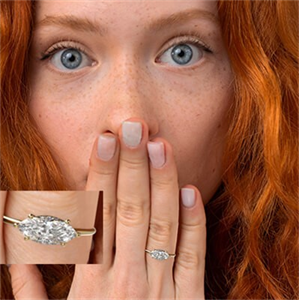
Image 1 East-West marquise setting
Choosing a Marquise Diamond
Are you romantic at heart and looking for an engagement ring that would give you an air of elegance? The Marquise diamond might be just the right choice for you. This diamond has a royal heritage and is good-looking. However, before you start shopping, there are important things to know.
A Brief History of the Marquise Diamond
The marquise diamond pronounced “mahr-keez” is a slender, elongated jewel stone with curved sides and pointed ends. It was introduced in France during the 1740s and legend has it that it derived its name from the shape of her lips when she smiled.
Also referred to as “navette” (Old French for little ship), this type looks like the hull of a racing yacht. The popularity of this type peaked during Edwardian era specially because sailing was a favorite pastime of King Edward VII and his wealthy peers in Britain. In the 1970’s, marquise diamonds were also quite popular especially in bridal jewelry but they were displaced by princess-cut diamonds which had square shapes by early twenty first century.
However, despite such fashion oscillations, the Marquise diamond still remains an excellent option. It gives an impression as if it is larger than a round shaped diamond with same carat weight. Moreover, many brides adore these stones since they make their fingers appear longer and slimmer.
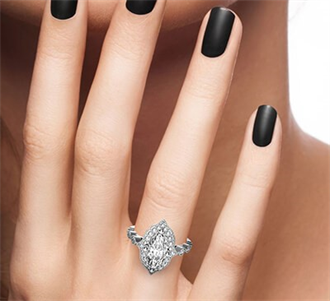
Image 2-Art Deco Marquise setting
How the Marquise diamond works?
The presence of a Marquise diamond in the design was an impeccable decision. The Art Deco styled design cleverly combined the iconic shapes of that era with a 1.01-carat center stone, 0.35 carats of rich round diamonds, and another 0.11 carats of diamonds to increase the sophistication of the ring.
Knowing how a marquise shape diamond is constructed.
A Marquise diamond is considered one of “fancy shapes” meaning those other than round. Crucial aspects to remember when looking for an amazing marquise shaped diamond include:
Belly: This is known as the widest or thickest part of a stone where its sides curve out at maximum angles; it determines the width.
Point: This refers to tips where two curved sides meet on both ends.
Wing: Refers to gently curved area connecting belly and tip.
Girdle: This is what happens when crown (top part) meets pavilion (lower facets), thus forming outer boundary of this gemstone.
Keel Line: It’s either arranged within or passes through culet facet at bottom of fancy cut gems.
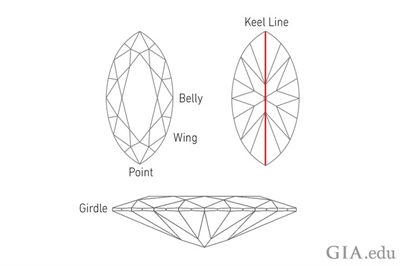
Image-3:The Anatomy of a Marquise Diamond and What to Look For
You need to know the anatomy of a Marquise diamond that includes belly, wing, point, girdle and keel line so that you can talk about which features are important to you.
Crucial Points in Choosing a Marquise Diamond
Various factors impact how Marquise-cut diamonds look; keep them mind as you choose your ideal Marquise diamond ring.
Girdles Thickness:
Thick girdles usually lead to chipping on one side, making it appear bigger from the top view of its table than it really is. On the other hand, with very thin girdles there are high chances for chipping which will make your diamond look larger as compared to what size it actually is.
For GIRDLE markings check out all parts of this slender area joining the top and bottom parts of the diamond. A brilliant-cut diamond’s GIRDLE has scallops that create “hill” or “valley” positions where upper and lower halves facets come together.
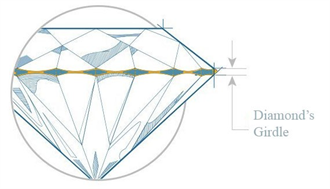
Image-4 The Ratio of Girdle Thickness to
Length-to-Width in Marquise Diamonds
Girdle thickness is assessed similarly for fancy shapes and round diamonds but certain fancy shapes such as the Marquise have specific considerations. Points on a Marquise-cut diamond are more vulnerable hence at these points a slightly thicker girdle is acceptable.
Length-to-Width Ratio:
The ratio of length to width in a diamond refers to how long it is from one point to another and then divide by how fat it is across the stomach. These ones usually have a value of 2:1, meaning that their length is almost twice the width.
Here are some examples of Marquise-cut diamonds with various length-to-width ratios:
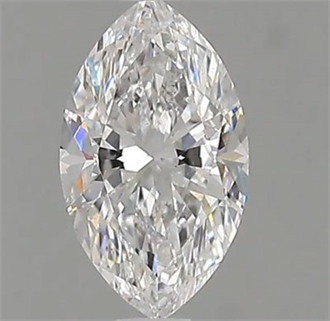
Image-5:This Marquise diamond is considered “a little short than usual”
it has a length-to-width ratio of 1.75:1.

Image 6:The proportions of this 1.50 Ct Marquise diamond are
closer to what the trade and consumers prefer,
it has a length-to-width ratio of 2.08:1. And have no
Bow-Tie effect! (read about it below)
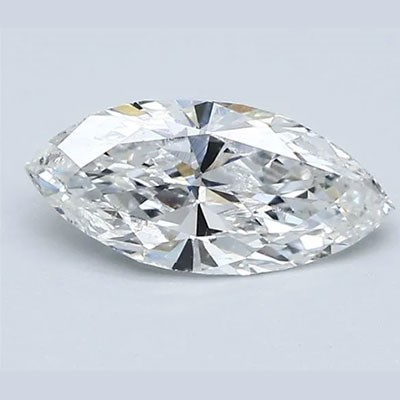
Image-7: This 1.55 Ct Marquise diamond would be considered
“a little too long” it has a length-to-width ratio of 2.20:1 and has a Bow-Tie

Buy colored Lab Diamonds, Add color to your life!
Marquise Diamonds and the Ideal Length-to-Width Ratio
The ideal length-width ratio for marquise diamonds usually falls between 1.75:1 and 2.10:1 as evidenced in GIA submitted diamonds. Longer Marquise shaped diamonds may be difficult to cut while still maintaining a good quality face up look of brightness and pattern Conversely, really short ones may appear “stubby”. Ultimately, what counts is the ratio that you personally find most attractive.
Symmetry:
In terms of design and overall visual appeal for the marquise diamond, symmetry plays a key role. The symmetry of a diamond according to GIA is assessed visually and graded on a five-point scale from Excellent to Poor. Consider these factors when evaluating the symmetry of a Marquise diamond:
Wings: Ensure that both wings have symmetrical curves. Each wing should have equal curvature.
Outline: Imagine there’s an imaginary line running straight across it at its belly point. Check if both halves are symmetrical in outline as well they should also be equal in length; none half should be longer or shorter than one another.
Facets: Picture yourself drawing an imaginary line down the length of this stone. In shape, size, or placement, all facets on both parts must be identical as well as check their symmetry on horizontal line across it. More symmetrical facets are usually considered better diamonds.
Missing or Extra Facets: Look for any inconsistencies in the number of facets.
Shape Appeal:
Not only does a Marquise diamond need to be symmetrically balanced but it should also possess gracefulness and visual beauty. This differs somewhat from that which is looked at during grading by examining overall aesthetics compared with other stones of similar shape and cutting style. Some common shape issues affecting whether people like certain diamonds more than others include:
Flat Wings: Wings having less curve than they normally have making them look flat.
Bulged Wings: Wings with too much curve, looking “fattier” than they should.
Uneven Wings: Wings having different degrees of curvature.
Undefined Points: Ends that are slightly rounded rather than pointed.
A Marquise diamond is a royal and flattering choice for an engagement ring. These tips will help you find one that suits your taste and preference.

Image-8:Marquise silhouettes, Image : Al Gilbertson GIA.edu
Marquise Diamonds vs. The Bow-Tie Effect
Viewing the diamond on the left in comparison with those in the three pictures on the right, one can actually notice how different shapes may influence the overall attractiveness of a Marquise diamond. Particularly, it is important to pay attention to the bow-tie effect that can be observed more clearly in two diamonds which are located on the left side.
Comprehending Bow-Tie Effects on Marquise Diamonds
Many marquise diamonds cut in brilliant style have a noticeable dark region across their width through table center when viewed face up resembling bow tie. This dark space could be from light gray to black; darker and wider bows are capable of greatly affecting diamond’s appearance.
Some degree of bow-tie is usual for Marquise diamonds (diamonds without bow-ties often look lifeless and less bright) but a little amount of bow-tie may seem attractive. However, very prominent ones may cause distraction. Such occurrences are common especially for shallow and excessive pavilion angles. There are slightly deeper pavilions and specific faceting variations that can help lessen this bow-tie effect.
To assess the extent of a bow-tie effect, one should see it as if he or she were grading it: face up without any magnification under normal light conditions at an average viewing distance with your hand underneath it as though you are wearing it remember that facets of a diamond act like mirrors by reflecting light within you back straight into your eyes some light will not reach your eye due to being blocked by your head therefore creating an area where there is brightness either side of darkness caused by your reflected head and shoulders -a shadowish tie.
The range between these two types depends upon its proportions as well as where one stands looking at it:
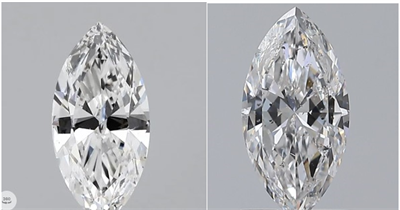
Image-9:Samples of strong-unpleasant bow ties
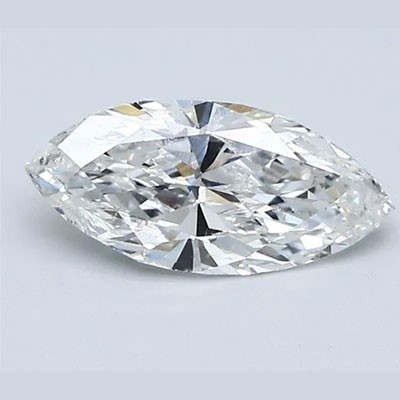
Image-10: Another unpleasant bow-tie effect
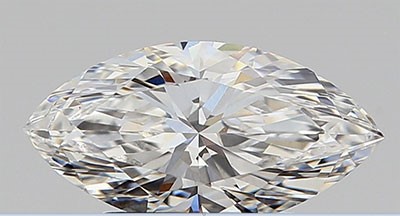
Image 11: No Bow-tie !
.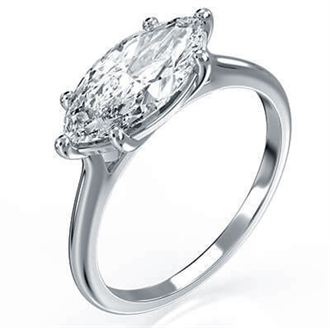
Image-12: Diamonds-USA solitaire ring features a 1.50 carat Marquise diamond
in an “east/west” orientation instead of “north/south. “That give the ring a distinctive flair.
Final words
When you wear a Marquise diamond, it seems like a taste of grandeur on your finger. A shape that is stunning with its oblong shape and pointed edges which together speak grace and class. If you are looking at this beautiful diamond for your future bride it is necessary to know what to look for in it. This includes factors like the diamond’s length-to-width ratio, symmetry and bow-tie effect that can affect its general appearance. A carefully selected Marquise diamond will not only mesmerize with its exceptional loveliness but also epitomize an ageless magic associated with royalty. Therefore, armed with this kind of knowledge, you will be able to confidently choose a Marquise diamond that will really make her feel unique.
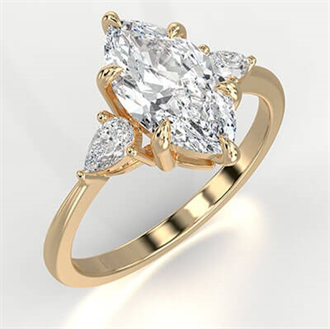
Image-13: Three stones engagement ring setting with side Pear diamonds